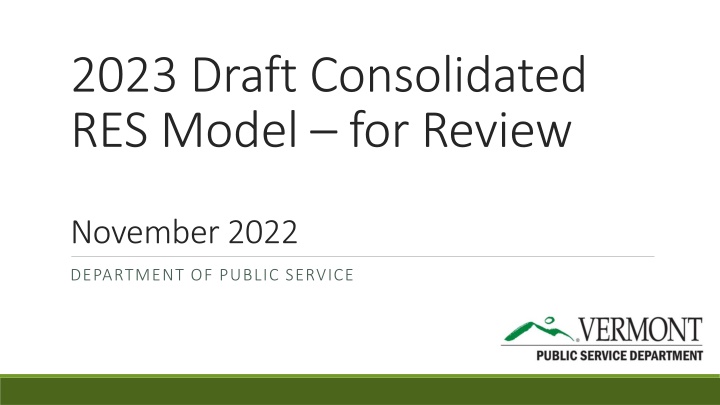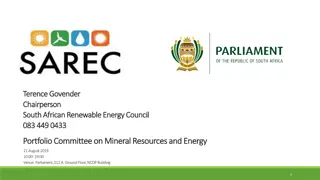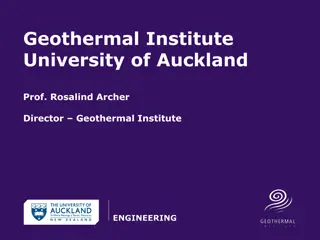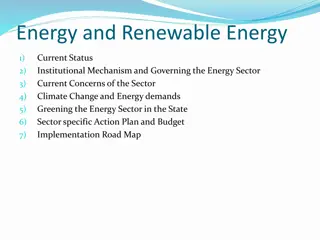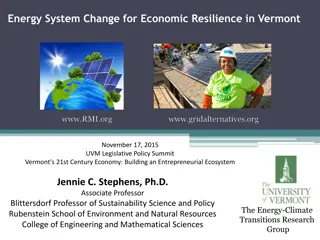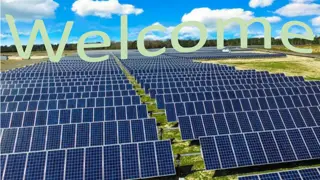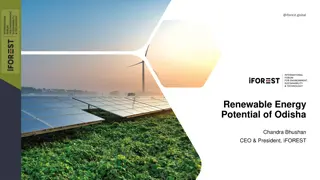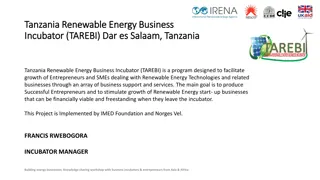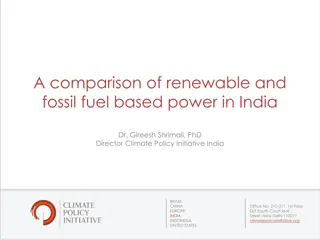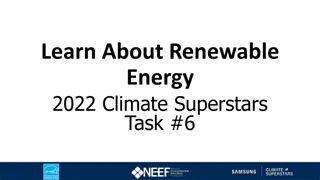Analysis of Vermont's Renewable Energy Standard and REC System
This document presents an overview of Vermont's Renewable Energy Standard (RES) and Renewable Energy Credits (RECs) system. It covers the establishment of the RES, specific requirements, eligibility criteria for RECs, and the different tiers of the RES. Key topics include the projection of impacts, model inputs, and outcomes. The REC system, its role in tracking renewable attributes, and value determination are also discussed. The document sheds light on tier-specific eligibility, compliance requirements, and alternative payment structures within Vermont's RES framework.
Download Presentation

Please find below an Image/Link to download the presentation.
The content on the website is provided AS IS for your information and personal use only. It may not be sold, licensed, or shared on other websites without obtaining consent from the author.If you encounter any issues during the download, it is possible that the publisher has removed the file from their server.
You are allowed to download the files provided on this website for personal or commercial use, subject to the condition that they are used lawfully. All files are the property of their respective owners.
The content on the website is provided AS IS for your information and personal use only. It may not be sold, licensed, or shared on other websites without obtaining consent from the author.
E N D
Presentation Transcript
2023 Draft Consolidated RES Model for Review November 2022 DEPARTMENT OF PUBLIC SERVICE
Topics Covered Overview of the Renewable Energy Standard (RES) Tiers I, II, and III Modeling Exercise 10-year projections of impact Required Outputs/Outcomes Model Inputs Draft Results 2
Vermont Renewable Energy Standard Vermont Title: Renewable Energy Standard. Established: 2005 (voluntary target); 2015 (standard). Requirement: 55% by 2017; 75% by 2032. Applicable Sectors: Investor-owned utility, municipal utilities, cooperative utilities, retail supplier. Cost Cap: Approximately 6%. Details: Distributed Generation: 10% by 2032. Energy Transformation: 12% by 2032 (includes weatherization, thermal energy efficiency, electric vehicles and heat pumps). Enabling Statute, Code or Order: Vt. Stat. Ann. tit. 30 8001 et seq.; Standard: House Bill 40. Source: https://www.ncsl.org/research/energy/renewable-portfolio-standards.aspx and https://programs.dsireusa.org/system/program/detail/5786/renewable-energy-standard
Renewable Energy Credits (RECs) RECs are the tool used for accounting, tracking and assigning ownership of environmental attributes. One Megawatt-Hour (MWh) of renewable generation = one REC RECs are used throughout U.S. to track renewability Creates fungible commodity that can be traded; Renewable attributes can be separated from underlying generation Attributes v RECs Creates uniform system for ensuring that there is no double counting Value of REC Theory is that REC value should represent the difference between the revenues a resource receives from wholesale markets (e.g. energy, capacity, reserves, etc.) and the cost to build Reality is that value is based on supply and demand Different Tier/Class eligibility means different values 4
Vermont RES Tier 1 Total Energy Eligibility any renewable resource that can deliver into New England, regardless of when resource was constructed. Includes resources from New York and Quebec Has largely been met with hydroelectric resources from New England, New York, and Canada Required Amounts: 55% of retail sales in 2017, increasing 4% every three years, until 75% in 2032 Tier II is included in Tier I Current Requirements: 2020-2022: 59% Maintained at 75% thereafter Alternative Compliance Payment = $10.58/REC in 2020, increasing by Consumer Price Index (CPI) annually 5
Vermont RES Tier 2 Distributed Generation Eligibility renewable resources commissioned after June 30, 2015; connected to a distribution or sub transmission line in Vermont; nameplate capacity of less than 5 MW Resources used to demonstrate compliance typically include net-metering, standard offer, utility PPAs Required Amounts: 1% of retail sales in 2017, increasing 0.6% every year, until 10% in 2032 Maintained at 10% thereafter Current Requirements: 2020: 2.8% 2021: 3.4% Carve out of Tier 1 requirements (not additional) Alternative Compliance Payment = $63.48/REC in 2020, increasing by Consumer Price Index (CPI) annually 6
Vermont RES Tier 3 Energy Transformation Purpose: Support fossil fuel reductions for utility customers Eligibility: electrification (vehicles, heat pumps); sawmills; sugaring operations; weatherization; Tier 2 RECs Required Amounts: 2% of retail sales in 2017, increasing by 0.67 % each year until reaching 12% in 2032 Maintained at 12% thereafter Later start date and lower overall requirement for small municipal utilities Alternative Compliance Payment = $ 63.48 /REC in 2020, increasing by CPI annually Costs vary considerably in terms of incentives paid to customers. Average cost was $51/ MWhe in 2020 7
RES Model Projections of Future Costs 2022-2031 30 V.S.A. 8005b(b)(2) requires the Public Service Department (PSD) to conduct an analysis of expected performance of the RES over a ten-year period utilizing a Consolidated RES Model to estimate the credible range of outcomes Outcomes: Cost Estimates of RES under various scenarios Rate pressure Carbon emission reductions Key inputs: Load forecast REC prices (Tiers I & II) Energy & Fossil Fuel Prices Tier III technologies and impact on peak loads Net-metering adoption rates Stakeholders are welcome to review the entire model to provide feedback. This deck is meant to succinctly summarize major factors influencing the results of the 2023 Consolidated RES model. 8
Modeling Exercise Scenarios Analyzed MODEL INPUTS LOW INCREMENTAL COST MOST LIKELY COST SCENARIO HIGH INCREMENTAL COST REC Price Forecast LOW MID HIGH Net Meter Adoption Rate LOW MID HIGH Peak contribution of New Load 10% 25% 75% Fossil Fuel Price HIGH MID LOW Load Forecast Scenario Baseline High Baseline High Baseline High 9
Model Input: Load Forecasts Vermont Load Forecast 9,000,000 Baseline Forecast (BAU): Baseline Forecast (BAU): Actual 2021 sales escalated at the rate of VELCO s 2021 Long-Range Transmission Plan 8,000,000 7,000,000 6,000,000 5,000,000 MWh 4,000,000 High Forecast (CEP/CAP): High Forecast (CEP/CAP): Based on modeling conducted for Comprehensive Energy Plan (CEP)/Global Warming Solutions Act (GWSA) carbon reduction pathways 3,000,000 2,000,000 1,000,000 - 2022 2023 2024 2025 2026 2027 2028 2029 2030 2031 PSD Adjusted BAU Forecast CEP/CAP Central Mitigation Scenario 10
Model Input: Tier I REC Scenarios Low Scenario: Low Scenario: Assumes some tapering in out years if new transmission lines bring Canadian Hydro to southern New England where these resources are valued for clean energy standards Tier I REC Price Scenario $18 $16 $14 Mid Scenario Scenario: Stable with current price trends $12 $ per MWh $10 High High Scenario Scenario: : Continued pricing at the Alternative Compliance Payment (ACP) $8 $6 Example Qualifying Resource Example Qualifying Resource: : Maine Class II RECs are a good proxy measurement of an existing resource that qualifies for Tier I. These RECs have recently traded at $8 to $11 per MWh $4 $2 $- 2022 2023 2024 2025 2026 2027 2028 2029 2030 2031 Low Mid High 11
Model Input: Tier II REC Scenarios Low Scenario: Low Scenario: Steady reductions as large new offshore wind resources come online Tier II REC Price Scenario $50 $45 $40 Mid Scenario Scenario: Stable with current price trends $35 $30 $ per MWh High High Scenario Scenario: : Delays/attrition of offshore wind projects result in higher prices in the low to mid $40s per MWh $25 $20 $15 Example Qualifying Resource: Example Qualifying Resource: Massachusetts Class I RECs are a good proxy measurement of an existing resource that qualifies for Tier II. These RECs have recently traded around $32 to $34 per MWh $10 $5 $- 2022 2023 2024 2025 2026 2027 2028 2029 2030 2031 Low Mid High 12
Model Input: Fossil Fuel Scenarios Fossil Heating Price Forecast Scenarios Low Scenario: Low Scenario: Slight decline from present $35.00 Mid Mid Scenario Scenario: : Stable with current $30.00 $/MMBtu for Residential Heating $25.00 High High Scenario Scenario: : Steady, growth from present $20.00 From EIA Annual Energy Outlook (AEO) 2022 Weighted average Residential $/MMBtuof oil, propane and gas Weights based on VT household fossil fuel for heating distribution (excludes wood and electric) 2022 AEO was published in March 2022 and may not fully price in recent increase in fossil fuel prices, especially propane/gas $15.00 $10.00 $5.00 $- 2022 2023 2024 2025 2026 2027 2028 2029 2030 2031 low mid high 13
Model Input: Tier III Technology Allocations Prior Modeling Assumptions Prior Modeling Assumptions: : Initial assumptions used for all prior year models Cold Climate Heat Pump Electric Vehicle Weatherization Custom Projects Tier II RECs 40% 40% 5% 10% 5% Draft 2023 Modeling Assumptions Draft 2023 Modeling Assumptions: : updated to better reflect actual Tier III measure savings to-date and expected savings distribution over the 10-year modeling period Cold Climate Heat Pump Electric Vehicle Weatherization Custom Projects Tier II RECs 56% 30% 2% 10% 2% 14
Model Input: Net Metering Adoption 2020 2020 - - 2021 = Actuals 2021 = Actuals Net Metering Deployment 450 2022 2022- -2031 Forecast = 2031 Forecast = from Vermont Electric Power Company (VELCO) 2021 Long-Range Transmission Plan 400 Installed Capacity (MW) 350 300 250 Low Low Scenario Scenario: : 50% of VELCO s forecasted net metering 200 150 100 Mid Mid Scenario Scenario: : 80% of VELCO s forecasted net metering 50 - High High Scenario Scenario: : 100% of VELCO s forecasted net metering low mid high VELCO 2021 Long Range Transmission Plan: https://www.velco.com/assets/documents/2021%20VLRTP%20to%20PUC_FINAL.pdf 15
Model Input: Wholesale Electric Prices Method 2022 YTD + average of Independent Service Operator of New England (ISO-NE) electric forwards over multiple months for end of 2022 and calendar 2023 Escalated at rate of Henry Hub gas forwards to 2031 Use New England wholesale price forecast trend is used to escalate the portion of current statewide cost of service (2021) tied to energy markets Cost of Service Share tied to Market 20% Wholesale market exposure limited to open positions and indirectly through long-term contracts with price components such fuel adjustment (biomass) or market- following (Hydro Quebec) price components Wholesale Energy Prices $120.00 $100.00 $80.00 $ per MWh $60.00 $40.00 $20.00 $- 2022 2023 2024 2025 2026 2027 2028 2029 2030 2031 Cost of Service Escalation share tied to market share tied to inflation share tied to depreciation *This assumption influences the projected cost of service tied to energy markets 20% 70% 10% 16
Model Input: Inflation Method Current 12-month average 6.6% Core Inflation curtailed by monetary policy over the 10yr model horizon, but near-term high inflation will bring the 10-year average up from historical ~2% Core inflation (CPI less food and energy) used because model already ties a portion of cost of service to energy ( share tied to market ) Use Model uses this as a trending tool to escalate the portion of current (2021) statewide cost of service tied to inflation over the modeling horizon of 2022-2031 Cost of Service tied to Inflation 70% Most T&D costs, many long-term power supply contracts, RES ACP all escalate at rate of inflation model assumption = 3.3% Cost of Service Escalation share tied to market share tied to inflation share tied to depreciation *This assumption influences the projected cost of service tied to inflation, a proxy for utility capital escalation 20% 70% 10% 17
Model Input: Depreciation 2022-2031 depreciation assumption = - -1% No change from prior years Cost of Service tied to Inflation 10% Assumption for COS share tied to depreciation taken from recent rate cases 1% Cost of Service Escalation share tied to market share tied to inflation share tied to depreciation *This assumption influences the projected cost of service tied to depreciation 20% 70% 10% 18
Current Year Model: DRAFT Projected Costs Estimated Cost of RES 2022-2031 $400,000,000 $377,000,000 $359,000,000 $350,000,000 $300,000,000 $237,000,000 $250,000,000 $227,000,000 $205,000,000 $196,000,000 $200,000,000 $150,000,000 $100,000,000 $50,000,000 $- Baseline High Baseline High Baseline High Lower Bound Likely Cost Upper Bound 19
Current Year Model: Estimated RES compliance costs: 2022-2031 LOW INCREMENTAL COST HIGH INCREMENTAL COST REC Price Forecast LOW HIGH Net Metering Adoption Rate LOW HIGH Peak contribution of New Load 10% 75% Fossil Fuel Price HIGH LOW Load Forecast Scenario Baseline High Baseline High Tier 1 Cost $87,000,000 $95,000,000 $190,000,000 $206,000,000 Tier 2 Cost $106,000,000 $113,000,000 $116,000,000 $125,000,000 +Tier 3 Cost $261,000,000 $278,000,000 $390,000,000 $325,000,000 -Tier 3 Additional Revenue -$258,000,000 -$281,000,000 -$256,000,000 -$279,000,000 Tier 3 Net Cost $3,000,000 -$3,000,000 $53,000,000 $46,000,000 TOTAL Cost of RES $196,000,000 $205,000,000 $359,000,000 $377,000,000 Rate Impact 1.86% 1.68% 4.99% 4.91% 20
Year-over-year notable changes Increase in projected 10-year RES costs compared to 2022 RES model (2021-2030) Likely Cost Estimate = ~25% increase over 2022 modeled Likely Cost Sharp increases in prices for Tier I RECs raises the expected price floor (lower bound). Maine Class II (existing renewables) are an example of a qualified Tier I resource traded regionally Is this a good measure of Tier I REC costs? What other resources could we use to forecast Tier I costs? $12.00 Maine Class II REC Prices $10.13 $10.00 $8.00 $6.00 $3.00 $4.00 $1.15 $2.00 $0.00 1/1/2018 3/1/2018 5/1/2018 7/1/2018 9/1/2018 11/1/2018 1/1/2019 3/1/2019 5/1/2019 7/1/2019 9/1/2019 11/1/2019 1/1/2020 3/1/2020 5/1/2020 7/1/2020 9/1/2020 11/1/2020 1/1/2021 3/1/2021 5/1/2021 7/1/2021 9/1/2021 11/1/2021 1/1/2022 3/1/2022 21
Year-over-year notable changes Other Notable changes Retail sales used for load forecast in this period (2021) is 1.5% higher than prior year (2020), RES requirements increase over time, so the model s embedded requirements are higher in this 10-year period than the 10-year period modeled last year Adjusting the technology allocation assumptions for Tier III resources to reflect actual and expected savings coming more from heat pumps than EVs results in higher costs. Heat pump consumption patterns lead to more usage during peak times than EVs, which are often encouraged to charge overnight during off-peak hours when energy is cheaper. Inflation and higher energy market prices also contribute to across-the-board higher costs of service and RES costs 22
Request for Feedback PSD would like feedback on the model inputs and assumptions described in this presentation Any other thoughts stakeholders have based on review of the model itself are also welcome Please send feedback or questions directly to: Please send feedback or questions directly to: adam.jacobs@vermont.gov adam.jacobs@vermont.gov Thank You! Thank You! 23
